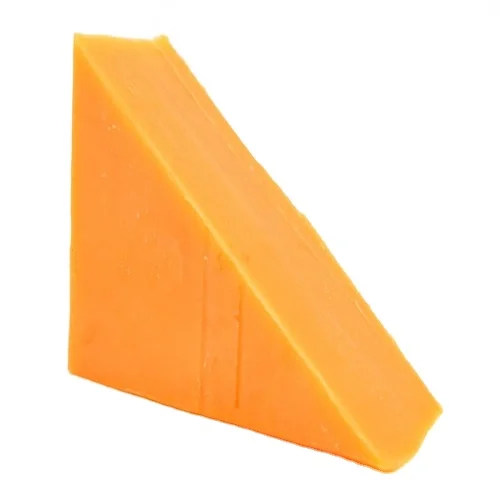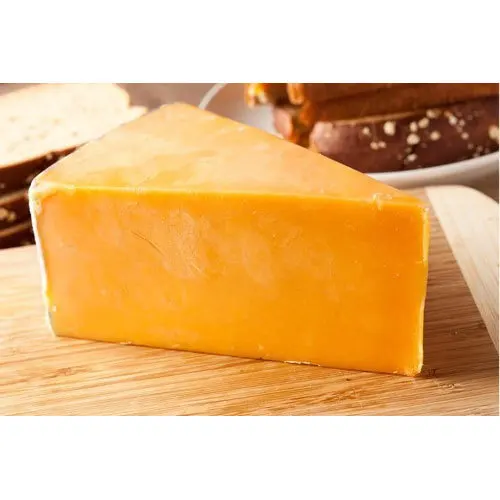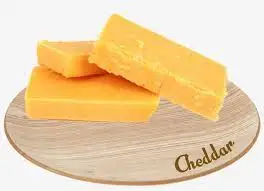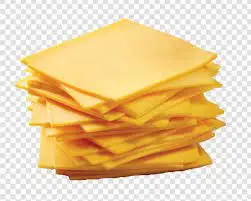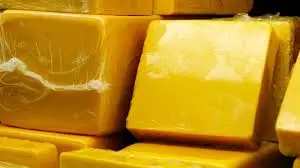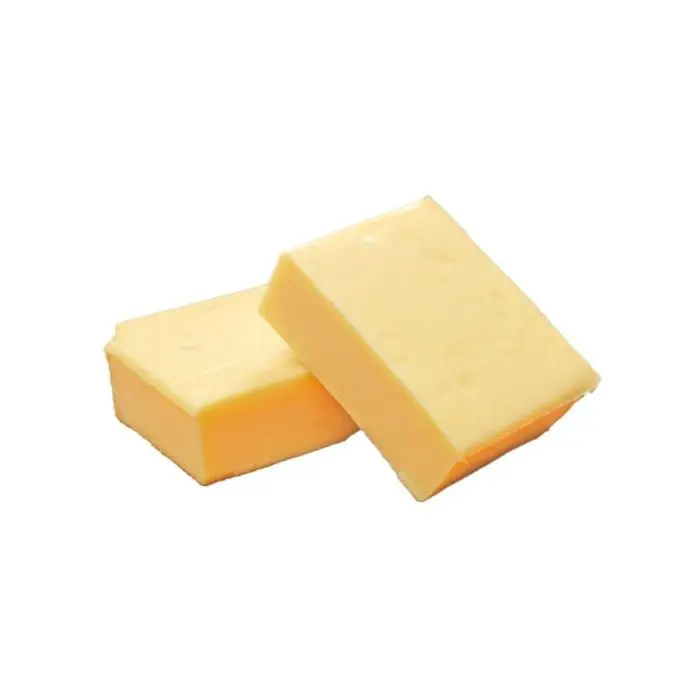Оптовая продажа сыр чеддер Лучшая
- Категория: Cheese & Analogues >>>
- Поставщик: REFRIMATICO,LLC
Поделиться:
Описание и отзывы
Трекер стоимости
| Месяц | Минимальная цена | Макс. стоимость |
|---|---|---|
| Sep-20-2025 | 0.2 $* | 0.77 $* |
| Aug-20-2025 | 0.12 $* | 0.96 $* |
| Jul-20-2025 | 0.97 $* | 0.93 $* |
| Jun-20-2025 | 0.86 $* | 0.80 $* |
| May-20-2025 | 0.80 $* | 0.34 $* |
| Apr-20-2025 | 0.0 $* | 0.27 $* |
| Mar-20-2025 | 0.64 $* | 0.54 $* |
| Feb-20-2025 | 0.36 $* | 0.75 $* |
| Jan-20-2025 | 0.6 $* | 0.40 $* |
Характеристики
Cheddar cheese is cheese made by the cheddaring process or by another procedure which produces a finished cheese having the same physical and chemical properties as the cheese produced by the cheddar process and is made from cow's milk with or without the addition of coloring matter and with common salt, contains not more than 39 percent of moisture, and in the water-free substance, contains not less than 50 percent of milkfat and conforms to the provisions of §19.500, “Definitions and Standards of Identity for Cheese and Cheese Products.” Food and Drug Administration (21 CFR 133.113)
- U.S. Grade AA cheddar cheese shall conform to the following requirements and specifications:
- Flavor. Fine and highly pleasing, free from undesirable flavors and odors. May possess very slight feed flavors. For detailed specifications and classification of flavor characteristics according to the degree of curing see Tables I and V.
- Body and texture. A plug drawn from the cheese shall be firm and appear solid, smooth, compact, close and should be translucent, although it may have a few small mechanical openings. May possess limited sweet holes in accordance with the degree of curing but free from other gas holes. For detailed specifications and classification of body and texture characteristics according to the degree of curing see Tables I and VI.
- Color. May be colored or uncolored but if colored, it should be a medium yellow-orange. May possess numerous tiny white specks associated with aged cheese. Very slight seaminess is permitted. For detailed specifications and classification of color characteristics according to the degree of curing see Tables I and VII.
- Finish and appearance
- Bandaged and paraffin-dipped. The rind shall be sound, firm and smooth providing a good protection to the cheese. The bandage shall be evenly placed on the end of the cheese and free from unnecessary overlapping and wrinkles and not burst or torn. The surface shall be smooth, bright, and have a good coating of paraffin or wax that adheres firmly to all surfaces of the cheese but may have mold under the bandage and paraffin within certain limited tolerances for the degree of curing. There shall be no indication that mold has entered the cheese. Shall be free from high edges, huffing and lopsidedness. For detailed specifications and classifications of finish and appearance characteristics according to the degree of curing see Tables I and VIII.
- Rindless. The wrapper or covering shall adequately and securely envelop the cheese, be neat, unbroken and fully protect the surface but may be slightly wrinkled. The cheese shall be free from huffing and lopsidedness and may have very slight mold under the wrapper or covering in medium and cured classifications. There shall be no indication that mold has entered the cheese. For detailed specifications and classifications of finish and appearance characteristics of rindless according to the degree of curing see Tables I and VIII.
- U.S. Grade A cheddar cheese shall conform to the following requirements and specifications:
- Flavor. Pleasing and free from undesirable flavors and odors. May possess feed, acid and bitter flavors within limited tolerances as the cheese ages. For detailed specifications and classification of flavor characteristics according to the degree of curing see Tables II and V.
- Body and texture. A plug drawn from the cheese shall appear reasonably solid, compact, close and should be translucent although it may have a few mechanical openings but may not be large and connecting. May not have more than two sweet holes on a plug but free from other gas holes. For detailed specifications and classification of body and texture characteristics according to the degree of curing see Tables II and VI.
- Color. May be colored or uncolored but if colored it should be a medium yellow-orange. May possess numerous tiny white specks, associated with aged cheese. May possess seaminess and waviness to a limited degree. For detailed specifications and classification of color characteristics according to the degree of curing see Tables II and VII.
- Finish and appearance
- Bandaged and paraffin-dipped. The rind shall be sound, firm and smooth, providing a good protection to the cheese. The bandage may be slightly uneven, overlapped or wrinkled, but not burst or torn. The surface shall be practically smooth, bright and have a good coating of paraffin or wax that adheres firmly to all surfaces of the cheese, with certain allowable tolerances for mold and other defects according to the degree of curing. There shall be no indication that mold has entered the cheese. Shall be free from huffing, but may have slightly high edges and be slightly lopsided. For detailed specifications and classification of finish and appearance characteristics according to the degree of curing see Tables II and VIII.
- Rindless. The wrapper or covering shall adequately and securely envelop the cheese, be neat, unbroken and fully protect the surface but may be slightly wrinkled. The cheese shall be free from huffing but may be slightly lopsided and may have very slight mold under the wrapper or covering in medium and cured classifications. There shall be no indication that mold has entered the cheese. For detailed specifications and classification of finish and appearance characteristics of rindless according to the degree of curing see Tables II and VIII.
- U.S. Grade B cheddar cheese shall conform to the following requirements and specifications:
- Flavor. May possess certain undesirable flavors to a limited degree in accordance with the aging of the cheese. For detailed specifications and classification of flavor characteristics according to the degree of curing see Tables III and V.
- Body and texture. A plug drawn from the cheese may be loose and open and may have numerous sweet holes, scattered yeast holes and other scattered gas holes; and may possess various body characteristics in accordance with degree of curing but pinny gas holes are not permitted. For detailed specifications and classification of body and texture characteristics according to the degree of curing see Tables III and VI.
- Color. May be colored or uncolored and possess various characteristics. For detailed specifications and classification of color characteristics according to the degree of during see Tables III and VII.
- Finish and appearance
- Bandaged and paraffin-dipped. The rind shall be sound, may be slightly weak, but free from soft spots, rind rot, cracks and openings of any kind. The bandage may be uneven and wrinkled but not burst or torn. The surface may be rough and unattractive but shall possess a fairly good coating of paraffin or wax. The paraffin may be scaly or blistered with mold and certain other characteristics permitted in accordance with the degree of curing but there shall be no indication that mold has entered the cheese. May be huffed, lopsided and have high edges. For detailed specifications and classification of finish and appearance characteristics according to the degree of curing see Tables III and VIII.
- Rindless. The covering or wrapper shall adequately and securely envelop the cheese, be fairly neat, unbroken and protect the surface but may be wrinkled. The cheese may be huffed, lopsided and have slight mold under the wrapper or covering in medium and cured classifications. There shall be no indication that mold has entered the cheese. For detailed specifications and classification of finish and appearance characteristics of rindless according to the degree of curing see Tables III and VIII.
- U.S. Grade C cheddar cheese shall conform to the following requirements and specifications:
- Flavor. May possess somewhat objectionable flavors and odors with certain increased tolerances in accordance with the degree of curing. For detailed specifications and classification of flavor characteristics according to the degree of curing see Tables IV and V.
- Body and texture. May be loose with large and connecting mechanical openings; possess various gas holes and body characteristics, with certain limitations and varying with the degree of curing. The cheese, however, shall be sufficiently compact to permit the drawing of a plug. For detailed specifications and classification of body and texture characteristics according to the degree of curing see Tables IV and VI.
- Color. May be colored or uncolored and possess various characteristics but not to the extent that the color is particularly unattractive. For detailed specifications and classification of color characteristics according to the degree of curing see Tables IV and VII.
- Finish and appearance
- Bandaged and paraffin-dipped. The rind may be weak and possess characteristics such as soft spots, rind rot, cracks, and openings, with certain limitations and varying with the degree of curing. The bandage may be uneven and wrinkled but not burst or torn. May have a very rough, unattractive appearance and the paraffin may be scaly and blistered, with mold and other characteristics permitted, varying with the degree of curing, but there shall be no evidence that mold has entered the cheese. May be huffed and lopsided and have high edges to a degree not permitted in the higher grades. For detailed specifications and classification of finish and appearance characteristics according to the degree of curing see Tables IV and VIII.
- Rindless. The wrapper or covering shall adequately and securely envelop the cheese, be unbroken and protect the surface but may be wrinkled and soiled. The cheese may be huffed, lopsided and have mold under the wrapper or covering in accordance with the degree of curing. There shall be no indication that mold has entered the cheese.
Cheddar Cheese Nutrition Facts
This nutrition information for 1 ounce (28g) of cheddar cheese is provided by the U.S. Department of Agriculture (USDA).1
Calories: 120
Fat: 10g
Sodium: 190mg
Carbohydrates: 0g
Fiber: 0g
Sugars: 1g
Protein: 7g
Calcium: 201.6mg
Vitamin A: 95.7mcg
Vitamin B12: 0.3mcg
Carbs
Like many kinds of cheese, cheddar contains zero carbohydrates. This means it also has no fiber and little to no sugar.
Fats
Most health concerns about cheddar focus on its fat content—and, more specifically, its content of saturated fat.2 It’s true that whole milk cheddar is high in both total fat (10 grams per ounce) and saturated fat (6 grams per ounce). Traditionally, nutrition advice has advised consuming a diet low in saturated fat to reduce the risk of cardiovascular disease.
However, new research suggests that, in whole foods such as cheese, saturated fat may not have the detrimental effects on heart health previously believed.3 Many experts are now calling for more research to determine the pros and cons of saturated fat in dairy.4
Protein
At 7g per 1-ounce serving, protein accounts for over 30% of cheddar’s calories. This can significantly add to your daily intake.
Vitamins and Minerals
Calcium is cheddar’s obvious micronutrient star, at 200mg (or 20% of your daily value) per ounce. But calcium isn’t the only vitamin or mineral cheddar has to offer. One ounce provides 10% of your daily vitamin A recommendation and 14% of your phosphorus, plus small amounts of zinc, selenium, and riboflavin. If you’re trying to cut down on salt, though, take note: Cheddar can be relatively high in sodium at 190mg per ounce.1
Health Benefits
Although most people might associate cheddar cheese with a range of comfort foods, it actually has quite a few notable nutritional benefits.
Builds Healthy Bones
With its sizable calcium content, cheddar can contribute to maintaining bone health. Getting enough calcium is critical to preventing osteoporosis, the harmful degeneration of bone density.5
Builds Muscle
Protein performs a variety of functions in the body, and at 7 grams per ounce, cheddar is a great source of this macronutrient. Not only does protein help build muscle, it’s necessary for the production of enzymes, giving structure to cells, maintaining fluid balance, and much more.6
Calorie Dense
No one could accuse cheddar of being full of empty calories! This cheese is calorie-dense, which increases its satiation factor.
May Help With Weight Loss
Despite what you may have heard about cheese causing weight gain, there's a a phenomenon known as the full-fat dairy paradox that's turning this belief on its head. Research now suggests that removing the fat from dairy products may actually make it more likely to cause weight gain, making full-fat the better choice for weight management.7
Compatible With Keto and Low-carb Diets
If you’re tweaking your macros on the keto diet, you’re in luck. Because of cheddar’s high percentage of fat, it’s compatible with this high-fat eating plan. With zero carbohydrates, cheddar also fits well in any low-carb diet.
Low Lactose
When it comes to lactose, not all cheeses are created equal. Cheddar is among the harder, aged cheeses that’s actually quite low in lactose, meaning that lactose intolerant folks can often eat it without unpleasant symptoms like bloating, stomach upset, and gas.
Allergies
Although it is low in lactose, cheddar still contains casein and whey, two components that can trigger an immune response in people with a dairy allergy.8 If you’re allergic to dairy, you’ll have to keep cheddar off the menu.
Varieties
You’ve probably noticed that cheddar comes in varying degrees of “sharpness,” including mild, medium, sharp, and extra-sharp. This simply refers to how long the cheese has been aged: the longer it ages, the sharper (or more pungent and flavorful) it becomes. Mild cheddar typically ages two to three months, while extra-sharp varieties can linger for up to a year.
And what about white cheddar? Intriguingly, all cheddar starts out white (or a shade close to it) since it comes from cow’s milk. In the seventeenth century, cheese producers began adding vegetable dye to cheddar to give it a consistent color, and the practice never stopped. Therefore, you might think of white cheddar simply as “original” cheddar. Any color differences from added extracts like annatto are unlikely to change the cheese’s flavor.
When It’s Best
There’s no one season for cheddar! This cheese can be aged and purchased all year long. However, to choose the best cheddar, it’s smart to read ingredient labels. Many shredded and sliced options are packaged with anti-caking agents like cellulose. While cellulose isn’t necessarily harmful, it may take away from the overall flavor and texture of your cheese.
Storage and Food Safety
It may be second nature to refrigerate all cheese, but cheddar does not technically require refrigeration. However, storing cheddar in the fridge will help it last longer. According to the USDA, unopened cheddar can last up to six months in the refrigerator and opened packages can stick around for three to four weeks.
Because it’s a hard cheese, cheddar even takes well to freezing—but you may not extend its life much more through freezing than through refrigeration. The USDA estimates cheddar can be frozen for about six months.
How to Prepare
Cheddar can make its way into any number of cheesy dishes or, of course, be served all on its own with your favorite crackers. With a melting point of about 150 degrees Fahrenheit, it doesn’t require high heat to get nice and gooey, and with its high fat content, it has plenty of stretch. To boost the nutrients in dishes like cheesy casseroles, Mexican dishes, sandwiches, or pastas, try using a whole grain base and adding veggies to the mix.



